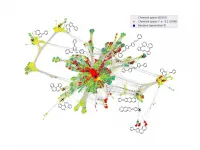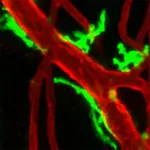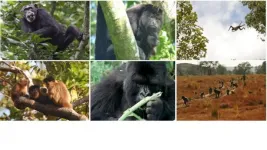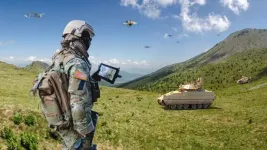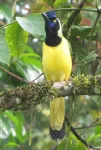INFORMATION:
DeepShake uses machine learning to rapidly estimate earthquake shaking intensity
2021-04-23
(Press-News.org) A deep spatiotemporal neural network trained on more than 36,000 earthquakes offers a new way of quickly predicting ground shaking intensity once an earthquake is underway, researchers report at the Seismological Society of America (SSA)'s 2021 Annual Meeting.
DeepShake analyzes seismic signals in real time and issues advanced warning of strong shaking based on the characteristics of the earliest detected waves from an earthquake.
DeepShake was developed by Daniel J. Wu, Avoy Datta, Weiqiang Zhu and William Ellsworth at Stanford University.
The earthquake data used to train the DeepShake network came from seismic recordings of the 2019 Ridgecrest, California sequence. When its developers tested DeepShake's potential using the actual shaking of the 5 July magnitude 7.1 Ridgecrest earthquake, the neural network sent simulated alerts between 7 and 13 seconds prior to the arrival of high intensity ground shaking to locations in the Ridgecrest area.
The authors stressed the novelty of using deep learning for rapid early warning and forecasting directly from seismic records alone. "DeepShake is able to pick up signals in seismic waveforms across dimensions of space and time," explained Datta.
DeepShake demonstrates the potential of machine learning models to improve the speed and accuracy of earthquake alert systems, he added.
"DeepShake aims to improve on earthquake early warnings by making its shaking estimates directly from ground motion observations, cutting out some of the intermediate steps used by more traditional warning systems," said Wu.
Many early warning systems first determine earthquake location and magnitude, and then calculate ground motion for a location based on ground motion prediction equations, Wu explained.
"Each of these steps can introduce error that can degrade the ground shaking forecast," he added.
To address this, the DeepShake team turned to a neural network approach. The series of algorithms that make up a neural network are trained without the researcher identifying which signals are "important" for the network to use in its predictions. The network learns which features optimally forecast the strength of future shaking directly from the data.
"We've noticed from building other neural networks for use in seismology that they can learn all sorts of interesting things, and so they might not need the epicenter and magnitude of the earthquake to make a good forecast," said Wu. "DeepShake is trained on a preselected network of seismic stations, so that the local characteristics of those stations become part of the training data."
"When training a machine learning model end to end, we really think that these models are able to leverage this additional information to improve accuracy," he said.
Wu, Datta and their colleagues see DeepShake as complementary to California's operational ShakeAlert, adding to the toolbox of earthquake early warning systems. "We're really excited about expanding DeepShake beyond Ridgecrest, and fortifying our work for the real world, including fail-cases such as downed stations and high network latency," added Datta.
ELSE PRESS RELEASES FROM THIS DATE:
Seismicity on Mars full of surprises, in first continuous year of data
2021-04-23
The SEIS seismometer package from the Mars InSight lander has collected its first continuous Martian year of data, revealing some surprises among the more than 500 marsquakes detected so far.
At the Seismological Society of America (SSA)'s 2021 Annual Meeting, Savas Ceylan of ETH Zürich discussed some of the findings from The Marsquake Service, the part of the InSight ground team that detects marsquakes and curates the planet's seismicity catalog.
Marsquakes differ from earthquakes in a number of ways, Ceylan explained. To begin with, they ...
Toward new solar cells with active learning
2021-04-23
How can I prepare myself for something I do not yet know? Scientists from the Fritz Haber Institute in Berlin and from the Technical University of Munich have addressed this almost philosophical question in the context of machine learning. Learning is no more than drawing on prior experience. In order to deal with a new situation, one needs to have dealt with roughly similar situations before. In machine learning, this correspondingly means that a learning algorithm needs to have been exposed to roughly similar data. But what can we do if there is a nearly infinite amount of possibilities so that it is simply impossible to generate data ...
Newly discovered immune cell function vital to healing
2021-04-23
Cardiovascular disease, the most common cause of death, is the result of oxygen deprivation as blood perfusion to affected tissue is prevented. To halt the development of the disease and to promote healing, re-establishment of blood flow is crucial. Researchers at Uppsala University have now discovered that one of the most common immune cells in the human body, macrophages, play an important role in re-establishing and controlling blood flow, something that can be used to develop new drugs.
The classic function of immune cells is to defend the body against attacks from microorganisms and tumour cells. Macrophages are immune cells specialised in killing and consuming microorganisms but they have ...
Travel paths of primates show how their minds work
2021-04-23
How primates get from A to B gives vital information about their cognitive evolution, say researchers in a new study looking at the travel paths of animals in the wild. Using data from 164 wild primate populations, the global survey examines the mental abilities that primates, including ourselves, use to know where and when to travel in the most efficient way.
A birds eye view
Co-author Miguel de Guinea, expert in Evolutionary Anthropology at Oxford Brookes University commented: "Imagine looking down on a huge outdoor market from high in the sky, perhaps from a drone hovering quietly above. The people below move in different ways. Some wander haphazardly among the stalls: they are learning what's available but are clearly not busy. Others take bee-line routes ...
Hubble captures giant star on the edge of destruction
2021-04-23
In celebration of the 31st anniversary of the launching of NASA's Hubble Space Telescope, astronomers aimed the renowned observatory at a brilliant "celebrity star," one of the brightest stars seen in our galaxy, surrounded by a glowing halo of gas and dust.
The price for the monster star's opulence is "living on the edge." The star, called AG Carinae, is waging a tug-of-war between gravity and radiation to avoid self-destruction.
The expanding shell of gas and dust that surrounds the star is about five light-years wide, which equals the distance from here to the nearest star beyond the Sun, Proxima Centauri.
The huge ...
New data could inform youth-focused pandemic messaging
2021-04-23
Now that teens and young adults across the country account for an increasing share of COVID-19 cases, and many have become eligible for vaccination, several recently published studies based on polls of this age group provide insights into the kinds of messaging that might work best for both preventing transmission and vaccine uptake.
Using data from text-message polls of people between the ages of 14 and 24 taken at several points in 2020, researchers from the University of Michigan find a clear theme: that most young people are taking COVID-19 seriously and trying to follow public health guidance, and that many of them they are motivated by the desire to protect ...
Army, ASU publish human-autonomy communication tips
2021-04-23
ABERDEEN PROVING GROUND, Md. -- Army and Arizona State University researchers identified a set of approaches to help scientists assess how well autonomous systems and humans communicate.
These approaches build on transformational scientific research efforts led by the Army's Robotics Collaborative Technology Alliance, which evolved the state of robots from tools to teammates and laid the foundation for much of the service's existing research into how humans and robots can work together effectively.
As ideas for autonomous systems evolve, and the possibilities ...
Critical understanding of why and how solid-state batteries
2021-04-23
Researchers from the Faraday Institution's SOLBAT project have made a significant step in understanding how and why solid-state batteries (SSBs) fail. A paper, published in Nature Materials on 22 April, provides answers to one important piece of the scientific puzzle.
To make step changes in electric vehicle (EV) battery range and safety at a lower cost, new battery chemistries that are "beyond lithium ion" must be developed. SSBs are one such promising technology, but mass market adoption has been held back by several key technical challenges that cause the battery to fail when charged and discharged.
SSBs can short circuit after repeating charging and discharging. One well-recognised cause of battery failure is the growth of dendrites, branching networks of lithium that ...
First description of a new octopus species without using a scalpel
2021-04-23
An evolutionary biologist from the University of Bonn brought a new octopus species to light from depths of more than 4,000 meters in the North Pacific Ocean. The sensational discovery made waves in the media a few years ago. Researchers in Bonn have now published the species description and named the animal "Emperor dumbo" (Grimpoteuthis imperator). Just as unusual as the organism is the researchers' approach: in order to describe the new species, they did not dissect the rare creature, but instead used non-destructive imaging techniques. The results have now been published in the prestigious journal BMC Biology.
In the summer of 2016, Dr. Alexander ...
Climate change impacts conservation sites across the Americas
2021-04-23
A continental-scale network of conservation sites is likely to remain effective under future climate change scenarios, despite a predicted shift in key species distributions.
New research, led by Durham University and published in the journal Frontiers in Ecology and Evolution, investigates the impacts of potential climate change scenarios on the network of Important Bird and Biodiversity Areas (IBAs) across the Caribbean, and Central and South America.
The research was carried out in collaboration with Senckenberg Biodiversity and Climate Research Centre, BirdLife International and the National Audubon Society.
IBAs are sites identified as being internationally important for the conservation of bird populations, with over 13,000 ...
